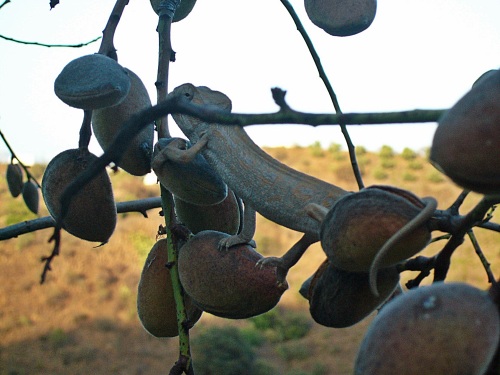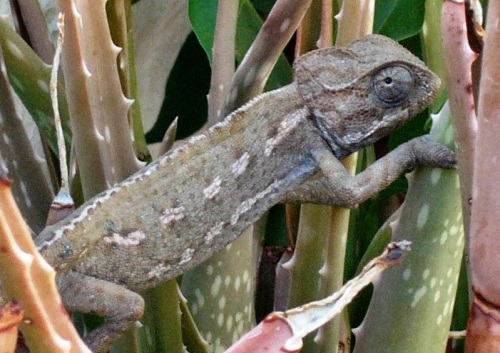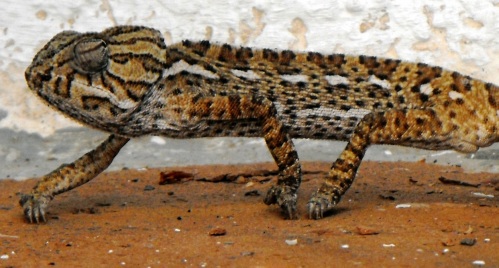
One of our “common” chameleons cruising the branches of almond trees
Summer is the season of the lizard, and perhaps the most beautiful and elegant of all lizards is the common or mediterranean chameleon that is appearing in gardens and patios now. Although they have been out and around since April, August is their breeding month. Males vigorously defend their territories that often include females, so they are more in evidence at this time of year.
In spite of their exotic nature everyone knows what you mean when you say “Chameleon”. They instantly bring to mind those swivelling eyes that move independently, the 360 degree vision, and a strong, prehensile tail that acts like a fifth limb. Most lizards have five fingers and toes but in the case of Chameleons these have fused into two thick opposed digits allowing them to grasp branches and inhabit shrub. They are Spain’s only arboreal lizard. The famous Chameleon tongue lies coiled up in its mouth like a spring, ready to hit a moving or even flying target at long-range. The tongue is sticky and whips back into the mouth, the prey attached. They are insect eaters and great demolishers of pests.
Chameleons are legendary for their ability to change colour and this is mistakenly thought to be a camouflage technique. In fact the chameleon’s ability to achieve absolute stillness, the excruciating slowness and smoothness of its movement and the slow sway of its gait hypnotises the observer while allowing it to melt away into the background. Strong colour changes are emotionally triggered. Corner or touch a chameleon and its turns dark with rage. Spectacular colour changes occur during sexual inter action and during face offs between males
It will surprise no one to learn that in spite of its name, “common” it is no longer common and in fact it is on the red list. This species is however listed as “Least Concern” because it is widely distributed, and because although it is declining it is unlikely to be declining fast enough to be listed in a more threatened category. The fact that it is on the red list makes it illegal to take or molest the species.
Where we live in the Axarquia the eastern part of Andalucia, is one of its last natural habitats. In this region it is still fairly plentiful. Locals and visitors ignorant of the law are still inclined to abuse chameleons. In a pub in Almachar a man places his evil smelling besocked foot on a bar table, releasing a “tame” (tethered) chameleon, where it entertains customers by picking off visiting flies with its sticky tongue. Children still “hunt” them. Drunks try to run them down in the road. Their gentle beauty has made them fatally valuable to the pet trade – legal in the past and illegal now and this is the major cause of their decline. Other causes are road building and other loss of habitat for example through tourism development, scrub fires, heavy insecticide use that destroys or pollutes their food, road kill and predation by domestic dogs and cats.

Chameleon among the aloes in our two bedroom cottage garden
Chamaeleo chamaeleon (Linnaeus, 1758) is native to the Atlantic coast of Western Sahara including Morocco, northern Algeria, northern and central Tunisia, northern Libya and northern Egypt. In southwestern Asia it occurs in southern Turkey, western Syria, Lebanon, Israel and western Jordan, western and southwestern Saudi Arabia and northern Yemen. Its attractiveness may account for its initial introduction to southern Spain and Portugal, probably around 1500. It now occurs along the southern coast of the Iberian peninsula, presumably introduced in response to the demands of the sixteenth century pet trade!
In the Axarquia chameleons occur in a density of 10-25 per hectare (2 1/2 acres), though double that has been recorded, so you are by no means guaranteed to see them even where they are said to be plentiful. Chameleons are day time lizards and you can find them climbing in bushes in shrub land, plantations, open pine woodland, orchards (such as almonds and olive groves) and gardens. I sometimes find one stalking by vegetable patch where the humidity is a bit higher. Chameleons, like all lizards are “cold-blooded” – their body temperature goes up and down with the environment. So look for them on hot sultry evenings and leave the midday sun to mad dogs and Englishmen. They are solitary beasts, barely tolerating each other or even members of the opposite sex during the breeding season. The females produce a single clutch of between five and forty-five eggs per year; these are buried in the soil and left to hatch.The babies fend for themselves.

same animal on the tiles and in a bad mood





Fantastic! That answers all my questions and more! Is it ok to publish in mag also?
Cheers
Mike
LikeLike
By: Mike-The Market Place on August 21, 2013
at 1:22 pm
Help yourself Mike. Do we get another advert?
LikeLike
By: puebloman on August 21, 2013
at 3:03 pm
I love chameleons! I was on the road from Cómpeta down to Torrox a couple of years ago when I came across one trying to cross the road – in his own inimitable way – two steps forwards and one hesitating step (almost) backwards.
Fortunately for the chameleon, I saw him in plenty of time, so I switched on the hazard lights, got out of car, and helped him across the road. Much to the amusement of some cars coming in the opposite direction!
LikeLike
By: Marianne on August 28, 2013
at 12:52 pm
Love it. Seventeen years in Spain and I’ve not seen one yet.
LikeLike
By: rachellynwebb on August 28, 2013
at 1:50 pm
[…] referred to as ”Pueblo Man” writes with a very easy style, and his latest offering, The Not-so-Common Chameleon, reminds us that this beautiful little creature is on the endangered list. I discovered the […]
LikeLike
By: CBBH Photo Challenge: PINK | East of Málaga .... and more! on September 1, 2013
at 6:52 am